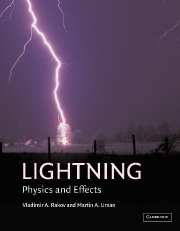Book contents
- Frontmatter
- Contents
- Preface
- 1 Introduction
- 2 Incidence of lightning
- 3 Electrical structure of lightning-producing clouds
- 4 Downward negative lightning discharges to ground
- 5 Positive and bipolar lightning discharges to ground
- 6 Upward lightning initiated by ground-based objects
- 7 Artificial initiation (triggering) of lightning by ground-based activity
- 8 Winter lightning in Japan
- 9 Cloud discharges
- 10 Lightning and airborne vehicles
- 11 Thunder
- 12 Modeling of lightning processes
- 13 The distant lightning electromagnetic environment: atmospherics, Schumann resonances, and whistlers
- 14 Lightning effects in the middle and upper atmosphere
- 15 Lightning effects on the chemistry of the atmosphere
- 16 Extraterrestrial lightning
- 17 Lightning locating systems
- 18 Deleterious effects of lightning and protective techniques
- 19 Lightning hazards to humans and animals
- 20 Ball lightning, bead lightning, and other unusual discharges
- Appendix: Books on lightning and related subjects
- Index
14 - Lightning effects in the middle and upper atmosphere
Published online by Cambridge University Press: 05 June 2013
- Frontmatter
- Contents
- Preface
- 1 Introduction
- 2 Incidence of lightning
- 3 Electrical structure of lightning-producing clouds
- 4 Downward negative lightning discharges to ground
- 5 Positive and bipolar lightning discharges to ground
- 6 Upward lightning initiated by ground-based objects
- 7 Artificial initiation (triggering) of lightning by ground-based activity
- 8 Winter lightning in Japan
- 9 Cloud discharges
- 10 Lightning and airborne vehicles
- 11 Thunder
- 12 Modeling of lightning processes
- 13 The distant lightning electromagnetic environment: atmospherics, Schumann resonances, and whistlers
- 14 Lightning effects in the middle and upper atmosphere
- 15 Lightning effects on the chemistry of the atmosphere
- 16 Extraterrestrial lightning
- 17 Lightning locating systems
- 18 Deleterious effects of lightning and protective techniques
- 19 Lightning hazards to humans and animals
- 20 Ball lightning, bead lightning, and other unusual discharges
- Appendix: Books on lightning and related subjects
- Index
Summary
… it is quite possible that a discharge between the top of the cloud and the ionosphere is a normal accompaniment of a lightning discharge to earth … and many years ago I observed what appeared to be discharges of this kind from a thundercloud below the horizon. There were diffuse, fan-shaped flashes of greenish colour extending up into a clear sky.
C.T.R. Wilson (1956)Introduction
For over a century prior to the scientific recordings of the 1990s, there were reports of visually observed lightning-like channels, pillars of light, and diffuse, upward-propagating, optical phenomena above thundercloud tops, sometimes apparently extending between the cloud tops and the ionosphere (e.g., Everett and Everett 1903; Boys 1926; Malan 1937; Ashmore 1950; Wright 1950; Wood 1951; Wilson 1956; Powell 1968; Corliss 1977, 1983; Vonnegut 1980; Vaughan and Vonnegut 1982; Vonnegut et al. 1989; Vaughan and Vonnegut 1989; Fisher 1990; Hammerstrom 1993). On theoretical grounds the existence of discharges in the rarified air between the thundercloud top and the lower ionosphere had been predicted by, for example, Wilson (1925a, b, 1956), Hoffman (1960), and Cole et al. (1966), all of whom viewed runaway electrons as the potential causative mechanism. Runaway electrons are defined as electrons whose initial energy is high enough that they gain more energy from the ambient electric field between collisions with air atoms than they lose in the collision process, and hence they continue to gain energy and increase in speed (Section 14.5). The first recording of luminous phenomena above cloud tops was serendipitously obtained in 1989 by Franz et al. (1990), while testing a new low-light video system.
Information
- Type
- Chapter
- Information
- LightningPhysics and Effects, pp. 480 - 506Publisher: Cambridge University PressPrint publication year: 2003
